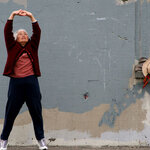Aging

17 genomes of supercentenarians, people living beyond 110 years of age, haven't led us any closer to discovering protein-altering variants significantly associated with extreme longevity, according to a study in PLOS ONE by Hinco Gierman from Stanford University and colleagues.
There are 74 supercentenarians alive worldwide, with 22 in the United States. The authors of this study performed whole-genome sequencing on 17 of them to explore the genetic basis underlying extreme human longevity.
It was a small sample size but even if it were large it may not make a difference. The…

There's a new reason not to go on a low-fat diet. The signs of brain aging can be postponed in mice if placed on a high-fat diet, which opens up the possibility for treatment of patients with Alzheimer's and Parkinson's disease.
When we get older, defects begin to develop in our nervous system and our brain loses some of its intellectual capacity. The risk of developing diseases such as Parkinson's and Alzheimer's also increases. Alzheimer's disease is currently the fastest-growing age-related disease.
Throughout our lives, it is important that our cells – to the extent possible –…

Each year nearly 2,000,000 Americans suffer osteoporosis-related fractures but after it happens, 53 percent of women received Dual X-ray Absorptiometry, the preferred technique for measuring bone mineral density and therefore osteoporosis, compared with only 18 percent of men.
As the population ages, fractures are expected to increase dramatically, placing a major burden on the health care system and a new study from Beth Israel Deaconess Medical Center (BIDMC) suggests that bias against men in favor of post-menopausal women will lead to lower quality of care and higher costs.
"…

What are the most important discussions to have among doctors, patients and families?
It seems obvious to just ask but there is a gap between what patients would like and the care they actually receive, according to a paper in the Canadian Medical Association Journal.
Current guidelines list 11 key elements for health care providers to discuss regarding end-of-life care, although these are based mainly on expert opinion and not on patient and family feedback.
A team of researchers with backgrounds in general internal medicine, critical care medicine and palliative care surveyed 233…

It's not all bad news for older brains. Credit: Shutterstock
By Angela Gutchess, Brandeis University
For years, conventional wisdom held that growing older tends to be bad news for brains.
Past behavioral data largely pointed to loss in cognitive – that is, thinking – abilities with age, including poorer memory and greater distractibility. Physical measures of brain structure also showed atrophy, or loss of volume, in many regions with age.
Watching older brains at work
Enter cognitive neuroscience, a subfield of psychology that incorporates methods from neuroscience. It uses measures of…

A diet rich in milk products is promoted as strengthening bones and reducing the likelihood of osteoporotic fractures, but dairy lobby marketing aside, actual research related to the benefits of milk for the prevention of fractures or influence on mortality rates has found evidence for and against.
A new study finds that high milk intake in women and men is not accompanied by a lower risk of fracture and instead may be associated with a higher rate of death.
There are lots of association papers that imply cause and effect - if you read one of those in mainstream media, it…

A few months ago, a Chinese team writing in Nature claimed to have found the cause for why organisms age, but a new group refuted a basic assumption of the Nature article.
The Chinese team led by
En-Zhi Shen caused a stir amongst experts worldwide. Using a simple measurement in young nematode worms, they reported they had been able to predict how long they would live. Mitochondria are present in most living organisms. They provide the energy for all processes of life and many biologists consider the mitochondria an important biological clock that drives aging. As an underlying…

A new paper from the International Osteoporosis Foundation (IOF) says that one-third of all hip fractures worldwide occur in men, with mortality rates as high as 37% in the first year following fracture.
This makes men twice as likely as women to die after a hip fracture. Osteoporosis experts warn that as men often remain undiagnosed and untreated, millions are left vulnerable to early death and disability, irrespective of fracture type.
The report entitled 'Osteoporosis in men: why change needs to happen' highlights that the ability of men to live independent pain-free lives into old…

Stretching the limits. Credit: Hey Mr Glen, CC BY-NC
By Joao Pedro de Magalhaes, University of Liverpool
When I was younger, about ten years old, I realized that everyone ages and dies. And I thought well why should that be?
Can’t we do something about it? I then thought I’d do it. I’ll study aging and figure it out, and I’ll find a solution so people don’t have to age and die. And that’s what I do today.
Aging is a decrease in viability and an increase in vulnerability. It means your capacity to respond to external stresses and to function decreases, making you more vulnerable to diseases.…

No one knows you like you know yourself so if you think your memory is slipping, you may be onto something. Self-reported memory complaints are strong predictors of clinical memory impairment later in life.
Richard Kryscio, PhD, Chairman of the Department of of Biostatistics and Associate Director of the Alzheimer's Disease Center at the University of Kentucky, and colleagues asked 531 people with an average age of 73 and free of dementia if they had noticed any changes in their memory in the prior year. The participants were also given annual memory and thinking tests for an…